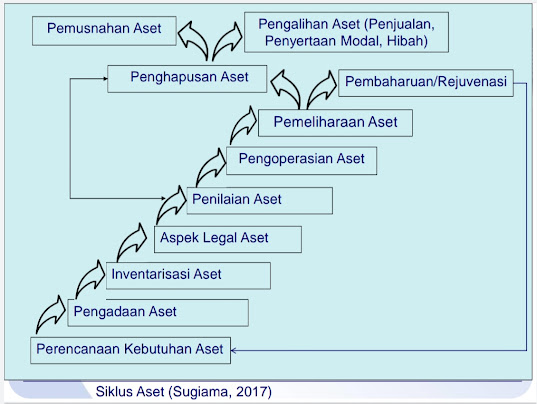A. First thing you should know
Asset Management is an important thing especially in realm of country development because in the era of globalization that we live in right now, state asset has a big impact in country development. Edward UP Nainggolan of The Ministry of Finance of Indonesia says that the contribution of state asset management to national development can be both tangible and intangible. the example of tangible contribution is the form of state revenues that are donated to the state development budget. the contribution comes from asset utilization, for example, utilization and transfer of assets. Therefore, the government must be able to identify unproductive government assets for immediate use of third parties in a transparent manner. meanwhile the example of intangible contibution is the form of benefits that received by state apparatus from assets, in carrying out their duties/serving the community or economic/social benefits received by the community. This is in accordance with the nature of government fixed assets. The role of government assets can be seen from their contribution to services and supporting the community's economy, such as infrastructure (road,bridge,drainage etc). So as we can see asset is the key to reach the walfare state. Both of Goverment and the people have to working together to make an optimal asset management so the country can develop.
B.The deffinition of asset,management, and asset management
Asset Management consist of two words, Asset and Management. So if we want to know what is Asset Management first we need to know about asset and management.
1.Asset
Sugiama (2013 : 15) argues that asset can be interpreted from various point of view that is based on the economic perspective and accounting perspective. From an economic perspective, an asset is anything that has economic value, can be owned by individuals,company or goverment and can be assessed financially. Sugiama (2013) also reveals that asset from economic point of view is a thing or anything that owned by individual,organization wether private or goverment that has :
- economic value
- commercial value
- exchange rate
- current wealth
- long-term assets or fixed asset
- prepaid and deffered assets
- intangible wealth
- Tangible asset (asset that can be manifested physically by using the five senses) for example land, buildings, infrastructure, factory or office equipment and supplies, vehicles, machinery etc.
- Intangible asset (assets whose manifestations are not physically tangible, that is, they cannot be touched, seen, or physically measured, but can be identified as wealth separately, and this wealth provides benefits and has certain economic value as a result of the business process or through time) for example patents, copyrights, goodwill, trademark rights etc.
- commercial assets such as assets that owned by a company which has a purpose for making profits. for example companies, malls, hotels, etc. here you can see a picture of commercial asset that i took :
- non-commercial assets such as government assets for public services. for example road,bridge,drainage,public hospital etc. the picture below is a photo of an example of non commercial asset that i took several months ago :
2.Management
If we want to know about what is management first we need to know who is manager itself.Millet (1954) argues that Manager is a person who directs and manages the performance of people who can be organized formally and as a group to achieve a common goal. So now we know about who is manajer then what is management? According to Handoko (2012:8) management is the process of planning, organizing, directing, and supervising the efforts of organizational members and the use of other organizational resources in order to achieve predetermined organizational goals.
3.Asset Management
Alright so now we know about what is Asset and what is management. But the question is what is Asset Management?According to Dr. A. Gima Sugiama (2013:15), Asset Management is the science and art to guide wealth management which includes the process of planning asset requirements, obtaining, taking inventory, conducting legal audits, assessing, operating, maintaining, renewing or eliminating assets to transfer assets in a timely manner. effective and efficient.
C.Cycle of Asset
Before the benefits of the asset can be received by a party, the asset must go through several stages or cycles. Sugiama (2016) argues that there are nine cycles of stage that is :
- asset requirements planning
- asset procurement
- asset inventory
- asset legal aspect
- asset valuation
- asset operation
- asset maintenance
- asset rejuvenation or disposal of asset
- transfer of assets through sales,grants,equity participation or asset destruction
D.Function of Asset Management
- asset requirements planning
- asset procurement
- asset inventory
- asset legal aspect
- asset valuation
- asset operation
- asset maintenance
- asset rejuvenation or disposal of asset
- transfer of assets through sales,grants,equity participation or asset destruction









Follow Us
Were this world an endless plain, and by sailing eastward we could for ever reach new distances